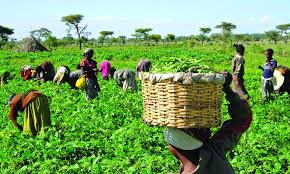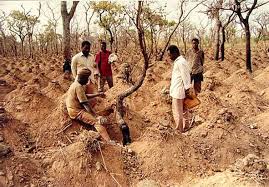![]()
If you’ve landed on this article page, you’re probably searching for a
good business idea—an idea that’s light on the pocket but heavy on
returns, promising both a fulfilling journey and potential profit.
|
How to start a lucrative Yam farming Cultivation in Nigeria
Yam farming refers to the cultivation and production of yam
crops, which are a staple food in many parts of Nigeria . Yam
farming involves the planting, nurturing, and harvesting of
yams, which are a tuber crop known for their high nutritional
value and culinary versatility. Yam farming is an important
agricultural activity in Nigeria , where yams are an essential
part of the diet and a significant source of income for many
small-scale farmers.
Yam production is the second-largest tuber crop produced in the
country. The local demand for yam in some states has exceeded
its production; hence yam is imported from neighboring states to
complete local production. Yam farming is very lucrative in
Nigeria.
Choosing the Yam Variety to Plant: There are different varieties
of yam in Nigeria. There are the Gboko yam, Zaki Ibiam yam,
Onitsha yam and Ebira yam etc.
Equipment to Use for Yam Farming:The following equipment can be
used for Yam farming: Tractors, Sprayers, Harrowers,
Plough,,Farm House, Power Tiller, Cutlasses, Hoes, Earth
Augers,Weeders etc.
Weed Control: Herbicides can be used for weed management in a
yam farm. The herbicides to be used must be the type that will
not affect the growth of the yam plant. Tools like cutlasses,
hoes, mechanized weeders and tillers can also be used for
weeding in yam farms.
Fertilizer and Manure
Management: Yam is a heavy feeder; it needs a lot of nutrients
to grow well. The ideal fertilizers for yam farming include NPK
15:15:15, NPK 12:12:17 and SSP (to be used at the initial stage
of planting). Calcium nitrate and potassium nitrate fertilizers
should be used during the stage of tuber initiation. These
fertilizers can significantly increase the yield of the yam
crop.
A soil test is advised to be done before the application of any
type of fertilizer.
Management of Pests and Diseases: Pesticides like insecticides,
fungicides, bactericides and nematicides etc. should be used to
prevent and manage pests and diseases in yam farms. Pesticides
can help yam farmers to assure good yield in Yam farming.
Pesticides like Belt Expert, Decis, Ampligo and Tihan etc. can
be used to manage pests and diseases in Yam farms.
Harvesting: Harvesting starts within 90 – 120 days after the
sowing of the seeds. Harvesting of the yam tubers in Nigeria is
usually done by hand. However, mechanized tools can be used for
the harvesting of the tubers.
Post-Harvest: Harvested
tubers are usually stored in barns or in a cool dry place before
they are sold in the market. Yam tubers can also be processed
into yam flour.
Yam farms can yield N 5,000, 000 – N 10,000, 000 million per
hectare (i.e. 100m x 100m).
Yam Production has been a life-changing enterprise for
the people of the country especially the North Central Nigeria,
North West Nigeria, and even the south west. Among other states
where yam is produced; these farmers live like politicians in
their environment.
Yam production in Nigeria has helped to reduce unemployment and
rural-urban migration in the state. Some notable reasons, why
yam has become lucrative in the country are to rich agricultural
land, the presence of poles for staking, the wide market, and
its usage for social and religious activities.
Yam can best intercrop with pepper or maize, but perform best on
sole cropping. You can earn money from your maize or pepper
while waiting for the yam to mature. Yam production requires
skills to be for effective performance.
Skills in Planning: Yam farming from production to marketing
requires proper planning. Planning itself is a skill you require
to achieve success in any organization. Planning has to do with
the decision on what needs to be done before venturing into the
enterprise.
Pre-Planting Skills
These are the skills you
need to have, before planting. You must adhere strictly to the
pre-planting agronomic practices of the crops in question
because if you fail to perform this agronomic practice it will
have negative implications on the growth and yield of your
crops. These skills are needed for preparing the land to receive
seeds.
Post-Planting Skills
Yam gives an average yield of 10 – 20t/ha.
Cure yam for 4-8 days by drying the tubers in the sun for a few
days.
Clean the yam with a knife or piece of the stick not with water
before long-term storage and marketing. Ensure that all the
roots are also removed so that the tuber has a smooth surface.
Water must not be used to clean tubers before storage because of
increased susceptibility to microbial infection and growth under
ambient humid storage conditions.
Marketing Skills:
Marketing is the pathway by which products reach the final
consumer. Farmers know the pay ways to get their products to
consumers. The farmers must know their target customers and the
channels through which the products will reach the customers for
effective sales
How long does it take yam to grow in Nigeria?
It takes Yam between 8 to 10 months to grow to full maturity in
Nigeria. At this time the yam stops growing, and the leaves turn
yellow which terminates toward the beginning of the dry season.
How to store yam?
How many tubers of yam per acre?
Get our training guide on how cultivate a lucrative Yam farming
Business
in Nigeria.
The body of this work is formed from consulting experienced and
relevant people running the Yam Farming Business, to get
first-hand information about the success secrets and marketing
strategies deployed to achieve business success
|







